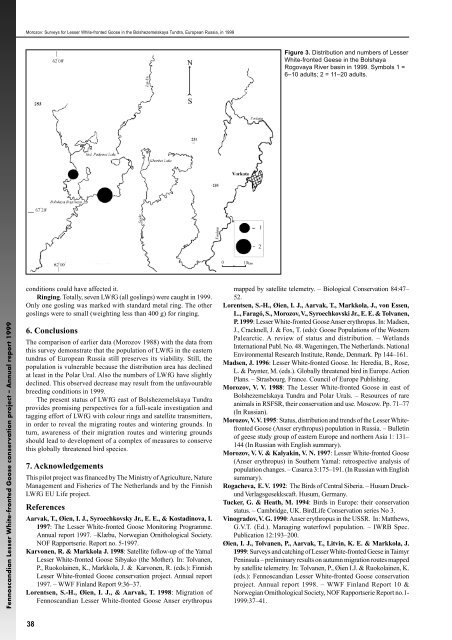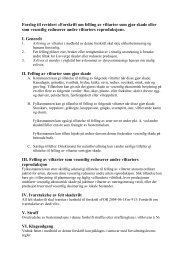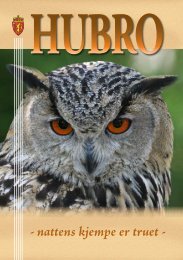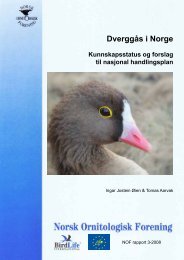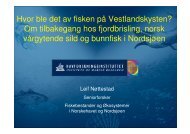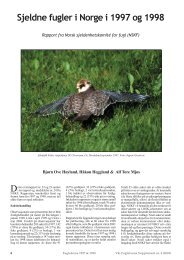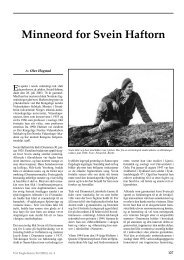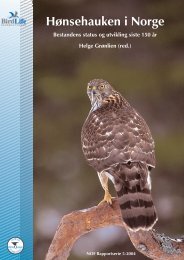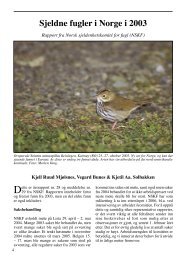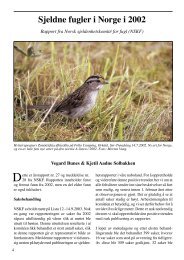Fennoscandian Lesser White-fronted Goose conservation project ...
Fennoscandian Lesser White-fronted Goose conservation project ...
Fennoscandian Lesser White-fronted Goose conservation project ...
You also want an ePaper? Increase the reach of your titles
YUMPU automatically turns print PDFs into web optimized ePapers that Google loves.
<strong>Fennoscandian</strong> <strong>Lesser</strong> <strong>White</strong>-<strong>fronted</strong> <strong>Goose</strong> <strong>conservation</strong> <strong>project</strong> – Annual report 1999<br />
Morozov: Surveys for <strong>Lesser</strong> <strong>White</strong>-<strong>fronted</strong> <strong>Goose</strong> in the Bolshezemelskaya Tundra, European Russia, in 1999<br />
conditions could have affected it.<br />
Ringing. Totally, seven LWfG (all goslings) were caught in 1999.<br />
Only one gosling was marked with standard metal ring. The other<br />
goslings were to small (weighting less than 400 g) for ringing.<br />
6. Conclusions<br />
The comparison of earlier data (Morozov 1988) with the data from<br />
this survey demonstrate that the population of LWfG in the eastern<br />
tundras of European Russia still preserves its viability. Still, the<br />
population is vulnerable because the distribution area has declined<br />
at least in the Polar Ural. Also the numbers of LWfG have slightly<br />
declined. This observed decrease may result from the unfavourable<br />
breeding conditions in 1999.<br />
The present status of LWfG east of Bolshezemelskaya Tundra<br />
provides promising perspectives for a full-scale investigation and<br />
tagging effort of LWfG with colour rings and satellite transmitters,<br />
in order to reveal the migrating routes and wintering grounds. In<br />
turn, awareness of their migration routes and wintering grounds<br />
should lead to development of a complex of measures to conserve<br />
this globally threatened bird species.<br />
7. Acknowledgements<br />
This pilot <strong>project</strong> was financed by The Ministry of Agriculture, Nature<br />
Management and Fisheries of The Netherlands and by the Finnish<br />
LWfG EU Life <strong>project</strong>.<br />
References<br />
Aarvak, T., Øien, I. J., Syroechkovsky Jr., E. E., & Kostadinova, I.<br />
1997: The <strong>Lesser</strong> <strong>White</strong>-<strong>fronted</strong> <strong>Goose</strong> Monitoring Programme.<br />
Annual report 1997. –Klæbu, Norwegian Ornithological Society.<br />
NOF Rapportserie. Report no. 5-1997.<br />
Karvonen, R. & Markkola J. 1998: Satellite follow-up of the Yamal<br />
<strong>Lesser</strong> <strong>White</strong>-<strong>fronted</strong> <strong>Goose</strong> Sibyako (the Mother). In: Tolvanen,<br />
P., Ruokolainen, K., Markkola, J. & Karvonen, R. (eds.): Finnish<br />
<strong>Lesser</strong> <strong>White</strong>-<strong>fronted</strong> <strong>Goose</strong> <strong>conservation</strong> <strong>project</strong>. Annual report<br />
1997. – WWF Finland Report 9:36–37.<br />
Lorentsen, S.-H., Øien, I. J., & Aarvak, T. 1998: Migration of<br />
<strong>Fennoscandian</strong> <strong>Lesser</strong> <strong>White</strong>-<strong>fronted</strong> <strong>Goose</strong> Anser erythropus<br />
38<br />
Figure 3. Distribution and numbers of <strong>Lesser</strong><br />
<strong>White</strong>-<strong>fronted</strong> Geese in the Bolshaya<br />
Rogovaya River basin in 1999. Symbols 1 =<br />
6–10 adults; 2 = 11–20 adults.<br />
mapped by satellite telemetry. – Biological Conservation 84:47–<br />
52.<br />
Lorentsen, S.-H., Øien, I. J., Aarvak, T., Markkola, J., von Essen,<br />
L., Faragó, S., Morozov, V., Syroechkovski Jr., E. E. & Tolvanen,<br />
P. 1999: <strong>Lesser</strong> <strong>White</strong>-<strong>fronted</strong> <strong>Goose</strong> Anser erythropus. In: Madsen,<br />
J., Cracknell, J. & Fox, T. (eds): <strong>Goose</strong> Populations of the Western<br />
Palearctic. A review of status and distribution. – Wetlands<br />
International Publ. No. 48. Wageningen, The Netherlands. National<br />
Environmental Research Institute, Rønde, Denmark. Pp 144–161.<br />
Madsen, J. 1996: <strong>Lesser</strong> <strong>White</strong>-<strong>fronted</strong> <strong>Goose</strong>. In: Heredia, B., Rose,<br />
L. & Paynter, M. (eds.). Globally threatened bird in Europe. Action<br />
Plans. – Strasbourg. France. Council of Europe Publishing.<br />
Morozov, V. V. 1988: The <strong>Lesser</strong> <strong>White</strong>-<strong>fronted</strong> <strong>Goose</strong> in east of<br />
Bolshezemelskaya Tundra and Polar Urals. – Resources of rare<br />
animals in RSFSR, their <strong>conservation</strong> and use. Moscow. Pp. 71–77<br />
(In Russian).<br />
Morozov, V. V. 1995: Status, distribution and trends of the <strong>Lesser</strong> <strong>White</strong><strong>fronted</strong><br />
<strong>Goose</strong> (Anser erythropus) population in Russia. – Bulletin<br />
of geese study group of eastern Europe and northern Asia 1: 131–<br />
144 (In Russian with English summary).<br />
Morozov, V. V. & Kalyakin, V. N. 1997: <strong>Lesser</strong> <strong>White</strong>-<strong>fronted</strong> <strong>Goose</strong><br />
(Anser erythropus) in Southern Yamal: retrospective analysis of<br />
population changes. – Casarca 3:175–191. (In Russian with English<br />
summary).<br />
Rogacheva, E. V. 1992: The Birds of Central Siberia. – Husum Druckund<br />
Verlagsgesekkscaft. Husum, Germany.<br />
Tucker, G. & Heath, M. 1994: Birds in Europe: their <strong>conservation</strong><br />
status. – Cambridge, UK. BirdLife Conservation series No 3.<br />
Vinogradov, V. G. 1990: Anser erythropus in the USSR. In: Matthews,<br />
G.V.T. (Ed.). Managing waterfowl population. – IWRB Spec.<br />
Publication 12:193–200.<br />
Øien, I. J., Tolvanen, P., Aarvak, T., Litvin, K. E. & Markkola, J.<br />
1999: Surveys and catching of <strong>Lesser</strong> <strong>White</strong>-<strong>fronted</strong> Geese in Taimyr<br />
Peninsula – preliminary results on autumn migration routes mapped<br />
by satellite telemetry. In: Tolvanen, P., Øien I.J. & Ruokolainen, K.<br />
(eds.): <strong>Fennoscandian</strong> <strong>Lesser</strong> <strong>White</strong>-<strong>fronted</strong> <strong>Goose</strong> <strong>conservation</strong><br />
<strong>project</strong>. Annual report 1998. – WWF Finland Report 10 &<br />
Norwegian Ornithological Society, NOF Rapportserie Report no.1-<br />
1999:37–41.


